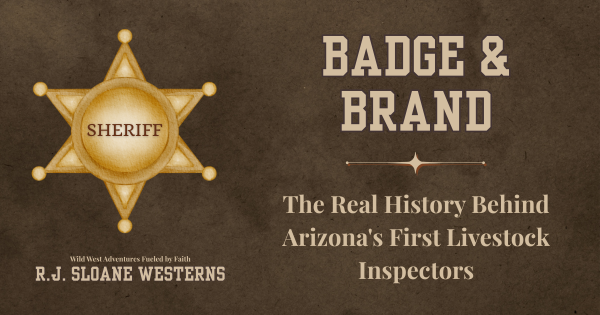Badge and Brand: The Real History Behind Arizona's First Livestock Inspectors

The desert wind carried the acrid smell of burning hair and flesh as Grady Thatcher examined the altered brand on the red Polled Shorthorn heifer. The scar tissue was raised and irregular, not the clean lines of a properly applied brand. Someone had taken a hot iron to this animal twice. First with its rightful owner's mark, then again to cover their crime.
For Grady, this wasn't just about stolen cattle. This was personal.
In 1893 Arizona Territory, when young men like Grady Thatcher and his methodical partner Deacon took their oaths as livestock inspectors, they were stepping into one of the frontier's most dangerous professions. These weren't cattle counters or brand clerks. They were detective-lawmen with badges, guns, and the authority to hunt down some of the most ruthless criminals in the American West.
When Honest Ranchers Demanded Action
By 1882, the Arizona Weekly Star reported that hundreds of cattle had been stolen and sold to butchers in Tombstone, Benson, and Tucson. Honest ranchers watched their herds disappear into sophisticated networks of rustlers who altered brands with surgical precision and moved stolen stock along established criminal routes.
These weren't desperate men stealing a cow for food. These were organized gangs with inside information, forged papers, and connections to corrupt buyers.
The cattlemen needed more than sheriffs who couldn't cross county lines or part-time deputies with no knowledge of cattle. They needed specialists who could read brands like fingerprints, spot disease used to cover theft, and track rustlers across the vast Arizona Territory.
The Birth of Official Justice
On March 10, 1887, the Arizona Territorial Legislature answered their call, creating the three-member Territorial Livestock Sanitary Commission. But it took four more years before the Commission appointed the first livestock inspectors on March 19, 1891.
The requirements were strict: five cattlemen, each owning at least fifty cattle, had to petition for an inspector in their area. This wasn't a job handed out to political favorites. It went to men who knew cattle, understood the frontier, and weren't afraid of hard work or danger.
Many of these first inspectors were former cattlemen or veterinarians. In Blood Justice, I've created characters Grady Thatcher and Deacon Colter who represent exactly this type of man—those who possessed the combination of veterinary knowledge and frontier courage that the territory desperately needed. They could examine a herd and spot altered brands through scar tissue patterns and hair growth. They understood cattle diseases and could tell when sickness was being used to cover theft.
The Perfect Cover for Personal Justice
For men carrying their own scores to settle, the livestock inspector badge offered something irresistible: legal authority to hunt the kind of criminals who destroyed families. The position came with jurisdiction across county lines, the power to coordinate with local sheriffs, and the responsibility to build court cases that would stick.
Grady had waited six years to make someone pay for the murder of his parents. Now, with a livestock inspector's badge, he had the perfect cover to hunt their killers across the Arizona Territory. The job description could have been written for him: travel throughout the territory, investigate complaints from ranchers, track down rustlers and recover stolen stock.
But when my characters Grady and Deacon investigated their first case of diseased cattle with altered brands, they discovered they were riding into something far more dangerous than simple cattle theft. This was about power, corruption, and buried secrets that led to organized criminal networks like The Mason Gang.
The Legacy of Frontier Justice
The livestock inspector's job wasn't just dangerous. It was deadly. These men faced organized gangs with military precision, inside information, and a willingness to kill anyone who threatened their operations. The criminals operated sophisticated networks that stole thousands of head worth tens of thousands of dollars across hundreds of miles of Arizona Territory.
The early livestock inspectors established something vital in Arizona's transition from frontier chaos to civilized order. They proved that justice didn't have to come from vigilante committees or secret cattlemen's associations. It could come from dedicated professionals with badges, legal authority, and the courage to face down the most dangerous criminals in the American West.
The Arizona Territorial Livestock Sanitary Commission evolved over the decades, becoming the Arizona Livestock Sanitary Board when Arizona achieved statehood in 1912. Brand registration shifted from county recorders to the livestock commission in 1895, and the territory's first brand book was published two years later.
These men walked the thin line between law and lawlessness, between justice and vengeance. In doing so, they helped build the foundation for modern Arizona, where men like the Harper siblings could transform a family legacy of crime into a tradition of frontier law enforcement.
The next time you see a cattle brand, remember the men who risked everything to make sure it belonged where it was supposed to be. In the brutal Arizona Territory of the 1890s, that simple mark burned into hide represented the difference between honest work and organized crime.
Discover how Grady Thatcher's personal quest for justice unfolds in Blood Justice, where the line between law and vengeance blurs in the dangerous world of Arizona Territory's livestock inspectors.